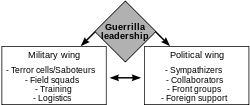Unconventional warfare
| Part of a series on |
| War |
|---|
Unconventional warfare is any kind of war that does not fit the traditional war between nations or groups. It includes foreign resistance movements and guerilla groups, who fight against an occupying force or their own government.
In conventional warfare, the fighters usually wear uniforms, which identifies them as fighters in an army, under the laws of war. With unconventional warfare, this is not the case. Those engaging in unconventional warfare need to hide before they can launch an attack. This means that in most cases they do not wear specific uniforms which identify them as fighters. Struggles of this type are going on at present in parts of Africa.
An unconventional war is rarely announced as a war. No declaration of war is made. Usually, the only feature which is noticed is the presence in a country of organised fighters. The fighters come from a neighbouring country or from parts of the existing country. There are no set rules.
This kind of warfare has been quite common since 1900. Terrorism is the intimidation of the native civilian population by armed fighters or insurgents, often known as guerrillas.[1] Warfare inside a state by citizens who wish to overthrow the state, also generally called terrorism by the government, has also been common.[2]
Struggle between regular forces (armies in uniforms) may happen without a formal declaration of war. Red versus white after the end of royal rule in Russia (Russian Civil War) is a good example. It was a semi-formal war, fought with regular troops on both sides.[3] So was the seizing of Manchuria (Manchukuo) by Japan in the early 1930s. Regular Japanese army forces were used.
After World War I and World War II unconventional forces were used to drive out colonial powers or to try and do so. The struggle against colonialism was usually by irregular forces supported by weapons and men from powers interested in removing the colonies (usually Russia or China).[4][5]
The dividing line between conventional and unconventional warfare is not clear-cut. In general conventional war is fought between regular armies, navies, air forces. Unconventional warfare is usually fought on the ground with at least one side not in uniform, usually against forces of the established government. It is an attempt to overthrow a government or to replace in it some part of the country.
Examples
- The Lord's Resistance Army was fighting against the government in Uganda, since about 1985. As of 2020, the conflict in Uganda seems to exist no longer, but it has spread to South Sudan, Tchad, and the Central African Republic. The conflict is known as Lord's Resistance Army insurgency. The leader of the Lord's Resistance Army, Joseph Kony, has been convicted of war crimes, and crimes against humanity.
- Boko Haram wants to make a new state, governed by Islamic law in the northern part of Nigeria. It is also active in Tchad, Niger and Cameroon. Since 2009, about 35.000 people were killed because of the conflict, there are about two million refugees because of the conflict.
- The Darfur conflict is a conflict in Sudan. Different local tribes fight against each other, and against the Sudanese government.
- Azawad is a territory in the north of Mali, which is almost entirely a desert. There is a conflict between the semi-nomadic Tuareg people, and local farmers. The Tuareg are represented by the National Movement for the Liberation of Azawad. The conflict is known as Mali War.
- The Casamance conflict is between the government of Senegal, and the Movement of Democratic Forces of Casamance. They want the region of Casamance to become independent from the rest of Senegal.
- The Cabinda War is fought between the government of Angola, and the Front for the Liberation of the Enclave of Cabinda. It wants the province of Cabinda to become an independent state.
USA definition
The USA Department of Defense defines unconventional warfare as activities conducted to enable a resistance movement or insurgency to coerce, disrupt, or overthrow a government or occupying power by operating through or with an underground, auxiliary, and guerrilla force in a denied area. Also called UW.[6]
Unconventional Warfare Media
Soviet Armed Forces members instruct Namibian SWAPO insurgents.
Colonel Benjamin Church (1639–1718) from the Plymouth Colony, father of unconventional warfare, American Ranging, and Rangers
References
- ↑ Greig, Ian 1973. Subversion: propaganda and the spread of people's war. London: Tom Stacey. ISBN 0-85468-495-6
- ↑ Payne, Robert (1950). Zero: The Story of Terrorism. J. Day Company. ISBN 978-0-598-77119-3. Retrieved 25 June 2019.
- ↑ Bulgakov M. 2008. White Guard. Yale University Press. ISBN 978-0-300-15145-9
- ↑ Thomson, Robert 1970. Revolutionary war in world strategy 1945–1969. London: Secker & Warburg. ISBN 978-0-800-86785-0
- ↑ Kitson, Frank1971. Low-intensity operations: subversion, insurgency & peacekeeping. London: Faber & Faber. ISBN 978-0-800-86785-0
- ↑ "Department of Defense Dictionary of Military and Associated Terms" (PDF). pp. JP 1-02. Retrieved 25 June 2019.


